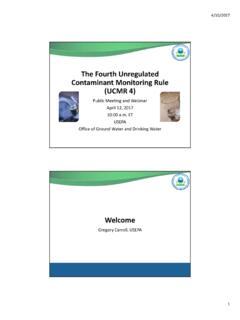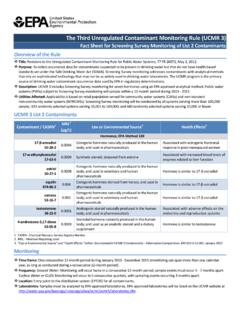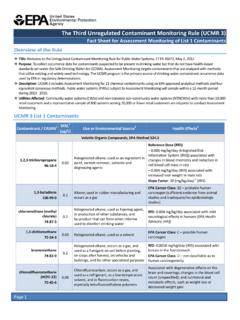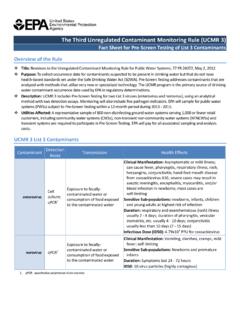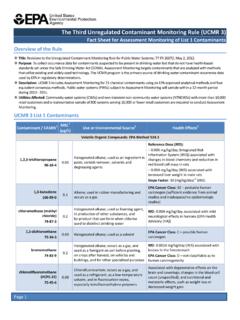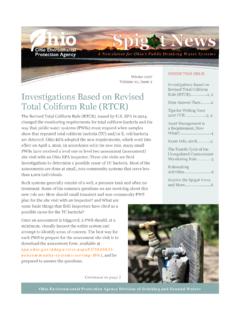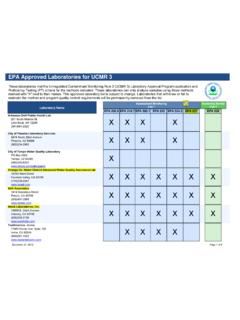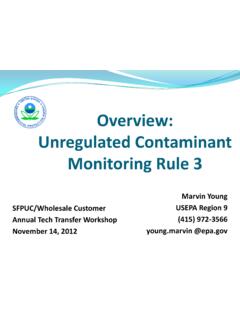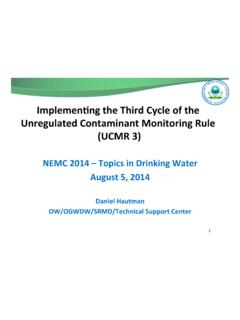Transcription of Unregulated Contaminant Monitoring Rule (UCMR4)
1 Unregulated Contaminant Monitoring Rule (UCMR4). Why UCMR? Implemented after the 1996 amendments to the Safe Drinking Water Act (SDWA). Required the EPA monitor no more than 30 contaminants every five years Contaminants not currently regulated Therefore it is required by the EPA. When is UCMR? Who is required to participate? Monitoring will begin in 2018 and end in 2020. Large public water systems, serving more than 10,000 people, are required to monitor A representative number of small public water systems selected by EPA, serving 10,000. people or less SC = 75 large PWSs and 28 small PWSs What is UCMR? Three types of assessment Monitoring : Assessment Monitoring 1 (Chemicals).
2 Assessment Monitoring 2 (HAAs & Indicators). Assessment Monitoring 3 (Cyanotoxins). What is UCMR? UCMR4 Monitoring Plan Type of Water AM1 AM2 AM3. System Chemicals HAAs & indicators Cyanotoxins (population). Small Systems Selected by EPA Selected by EPA Selected SW. (25-10,000) [SC = 11 PWSs] [SC = 10 PWSs] [SC = 17 PWSs]. All SW. All (including systems that Large Systems All [SC = 75 PWSs] purchase surface water). (>10,000) [SC = 75 PWSs]. [SC = 67 PWSs]. Assessment Monitoring 1. (Chemicals). Metals: germanium, manganese Pesticides: alpha-hexachlorocyclohexane, chlorpyrifos, dimethipin, ethoprop, oxyfluorfen, profenofos, tabuconazole, total permethrin (cis- &.)
3 Trans-), tribufos Alcohols: 1-butanol, 2-methoxyethanol, 2-propen-1-ol Semivolatiles: butylated hydroxyanisole, o-toluidine, quinoline Assessment Monitoring 2 (HAAs & Indicators). Indicators Total Organic Bromide Carbon Assessment Monitoring 3. (Cyanotoxins). Total microcystins Anatoxin-a Microcystin-LA Cylindrospermopsin Microcystin-LF. Microcystin-LY. Microcystin-RR. Microcystin-YR. Nodularin Where are my UCMR sampling locations? AM1. at each entry point to distribution system if purchasing, at connection (or master meter location), and if more than one connection, at connection of highest volume large GW systems are eligible to submit ground water representative Monitoring plan (GWRMP) for approval, deadline 10/31/17.
4 GWRMP? Large GW systems or Large SW systems that have GW sources are eligible to submit ground water representative Monitoring plan (GWRMP) for approval, deadline to submit required documentation to EPA is 10/31/17. DHEC DW Compliance, Richard Welch and engineers, will need approximately 2 weeks to review/approve; please contact if you need assistance Where are my UCMR sampling locations? AM2 HAAs = Stage 2 DBP Rule sites AM2 Indicators Raw water before treatment Collected at the same time as AM2 HAA samples Surface water purchased not required Where are my UCMR sampling locations? AM3 Cyanotoxins Entry point to distribution system Surface water purchased at master meter connection Highest volume if multiple meters How often do I sample?
5 AM1 and AM2: Surface water systems 4 sampling events, 4. consecutive quarters Groundwater systems 2 sampling events, the 2nd sampling event occurring between 5-7 months following the 1st sampling event AM3: Surface water systems and surface water purchasing systems 8 sampling events, every other week, 4. consecutive months (excluding December-February). What does it cost? Monitoring Plan/Method(s) Est Cost per Sample AM1-Metals/EPA , ASTM D5673-10, SM 31253 $80. AM1-Pesticides/EPA $415. AM1-Alcohols/EPA 541 $337. AM1-Semivolatiles/EPA 530 $384. AM2-HAAs/EPA or 557 $194. AM2-Indicator-TOC/SM5310B, SM5310C, SM5310D, EPA $61.
6 AM2-Indicator-Bromide/EPA , , , , ASTMD6581-12 $55. AM3-Cyanotoxin total microcystins /EPA 546 Adda ELISA $163. AM3-Cyanotoxin specific microcystins /EPA 544 $445. AM3-Cylindrospermopsin and anatoxin-a/EPA 545 $428. Example: Blue Water System, SC1234567, is a large surface water system with an additional ground water source and two DBP sampling locations. They have confirmed their inventory in their CDX/SDWARS account as: Facility ID Facility Name Facility Type Water Type Sample Point Sample Point ID Name 12345 Blue Water SW TP SW A12345 Blue Water SW. TP TP. 12678 Running River IN SW S12678 Running River Intake 12543 Plant 1 TP GW B12543 Plant 1-well 1.
7 12876 Well 1 WL GW G12876 Well 1. 99001 Distribution DS MX DBP20 654 Water Way 99001 Distribution DS MX DBP21 321 Water Ave Sample Sample Point Monitoring SE1 SE2 SE3 SE4 SE5 SE6 SE7 SE8 Est Cost Point ID Name Requirement A12345 Blue Water SW TP AM1 Jun Sep Dec Mar $4864. 2019 2019 2019 2020. B12543 Plant 1-well 1 AM1 Jun Dec $2432. 2019 2019. DBP20 654 Water Way AM2 Jun Sep Dec Mar $776. 2019 2019 2019 2020. DBP21 321 Water Ave AM2 Jun Sep Dec Mar $776. 2019 2019 2019 2020. S12678 Running River AM2-TOC/Br Jun Sep Dec Mar $464. Intake 2019 2019 2019 2020. G12876 Well 1 AM2-TOC/Br Jun Dec $232. 2019 2019. A12345 Blue Water SW TP AM3* Jun Jun Jul Jul Aug Aug Sep Sep $4728.
8 *all results for 546 2020- 2020- 2020- 2020- 2020- 2020- 2020- 2020- < g/L wk 1 wk 3 wk 1 wk 3 wk 1 wk 3 wk 1 wk 3. Total Cost (estimated) $14,272. AM3-Cyanotoxins Three samples collected at EPTDS, one for each method (546, 544, 545). If 546 result for total microcystins is less than g/L, then the sample for 544 will not be analyzed and only the total microcystin result will be reported If 546 result is greater than or equal to g/L, the 546 result is reported and the sample for 544 is analyzed and reported (EPA estimates 2% of samples will trigger). Method 545 will be collected, analyzed and reported AM3-Cyanotoxins For each sampling event, the water system will be required to answer 4 questions through their Central Data Exchange (CDX)/Safe Drinking Water Accession and Review System (SDWARS).
9 The questions are designed to help the EPA understand the quality of the source water at the time of the sampling event. BLOOM OCCURRENCE CYANOTOXIN INDICATOR OF POSSIBLE INDICATOR OF POSSIBLE. OCCURRENCE BLOOM-TREATMENT BLOOM-SOURCE WATER. QUALITY PARAMETERS. Who analyzes? Samples must be analyzed by an EPA UCMR. approved lab using EPA UCMR approved methods. Detailed information regarding methods can be found on EPA's UCMR home page, . Who analyzes? Water system laboratories that wish to exclusively analyze TOC and/or bromide samples must email by December 1, 2017 to register for the Lab Approval Program. Next, the water system laboratory must complete the registration and submit documentation that they are authorized by their primacy state to analyze TOC.
10 And/or bromide samples by December 15, 2017. What do I do now? Water systems update contact information, zip code(s), sampling location(s), inventory information and Monitoring schedules in their CDX/SDWARS account. Deadline 12/31/17. What do I do now? Select an EPA UCMR approved lab using EPA. UCMR approved methods. Details regarding labs and methods will be found at . What do I do now? Once sampling begins, labs will post data to SDWARS within 120 days of sample collection. PWS Administrative Contact and/or Technical Contact should review/approve data via CDX within 60 days of lab posting. If PWS does not review/approve within 60 days, data automatically approved and ready for state and EPA.
